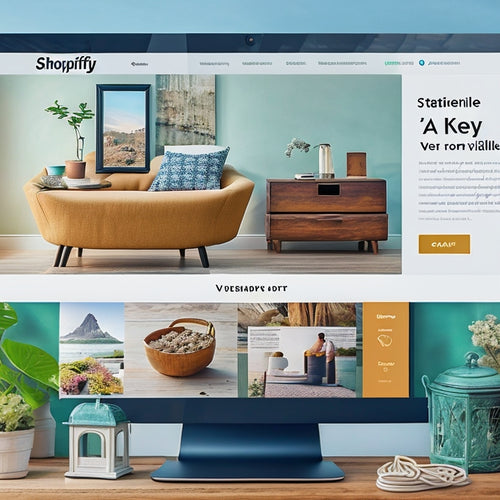
Pricing Strategies: 3 Psychology-Backed Tips for Success
Share
You're about to reveal the secret to making your pricing strategy a major competitive advantage, backed by the psychology that drives customer purchasing decisions. First, use anchors to influence customers' understanding of value, making lower prices seem more reasonable by displaying them next to higher-priced options. Next, leverage scarcity and exclusivity to create a sense of urgency, increasing sales through FOMO and VIP experiences. Finally, frame price perceptions by emphasizing benefits, creating a sense of ownership, and shifting focus from cost to value. Now, get ready to perfect your pricing strategy and discover even more sales-boosting tactics.
Key Takeaways
• Use anchors to influence customers' value perception by setting high prices for premium products to make lower prices seem more reasonable.
• Create a sense of urgency and exclusivity by limiting product availability, offering limited-time deals, and providing VIP experiences to drive sales and increase willingness to pay premium prices.
• Emphasize the benefits and unique features of a product by framing prices effectively, shifting the focus from cost to value and investment.
• Use language that creates a sense of ownership and belonging to increase customer willingness to pay premium prices for products that offer exclusive experiences.
• Highlight the unique features and benefits of a product by comparing it to others, making premium offerings seem worthwhile and increasing customer value perception.
The Power of Anchors
When you're determining prices for your products or services, you're likely unaware of the subtle influence of anchors on your customers' perceptions.
Anchors are reference points that shape your customers' understanding of value, and they can greatly impact your pricing strategy. The anchoring effect, a fundamental concept in pricing psychology, suggests that people rely heavily on the first piece of information they receive when making a decision.
This means that if you set a high anchor, your customers will perceive lower prices as more reasonable. For instance, if you're selling a luxury watch, you might display a higher-priced model next to a lower-priced one to make the latter seem more affordable.
Scarcity and Exclusivity
As you strategically place anchors to influence your customers' perceptions, you can further optimize your pricing strategy by leveraging the psychological power of scarcity and exclusivity to create a sense of urgency and prestige around your products or services.
By limiting availability or offering exclusive deals, you can create a sense of FOMO (fear of missing out) that drives sales. This is where urgency tactics come into play, such as limited-time offers, countdown timers, or exclusive access to new products.
You can also create VIP experiences that make customers feel valued and special, increasing their willingness to pay premium prices. This could be through early access to new products, personalized service, or exclusive events.
Framing Price Perceptions
You can powerfully influence how customers perceive your prices by strategically framing the value of your products or services, making even the most premium offerings seem like a smart investment. By doing so, you can shift the focus from the price itself to the benefits and value it provides.
Here are three ways to frame your prices effectively:
-
Use price comparison: Highlight how your product or service compares to others in the market, emphasizing the unique features and benefits that justify the price. This helps customers understand the value they're getting for their money.
-
Emphasize the investment, not the cost: Instead of focusing on the price, position your product or service as an investment in the customer's well-being, success, or happiness. This changes the way customers think about the price, making it a worthwhile expenditure rather than a costly expense.
-
Create a sense of ownership: Use language that makes customers feel like they're getting a valuable possession or experience, rather than just buying a product or service. This can be achieved by using words like 'yours' or 'exclusive access' to create a sense of ownership and belonging.
Frequently Asked Questions
How Do I Determine the Optimal Price for My Product or Service?
You determine the best price by conducting market research and competitive analysis to understand your target audience's willingness to pay, then align it with your unique value proposition and pricing psychology to maximize revenue and profitability.
What Is the Impact of Pricing on Customer Loyalty and Retention?
"Like a master chef seasoning a dish, you balance pricing to flavor customer perception, fostering loyalty and retention. A well-crafted pricing strategy can be the secret ingredient, making customers stick to your brand like glue."
Can I Use Pricing Strategies for Both B2B and B2C Markets?
You can adapt pricing strategies for both B2B and B2C markets by understanding pricing psychology and segmenting your market to tailor approaches that resonate with each audience's unique needs and values.
How Often Should I Adjust My Pricing Strategy to Stay Competitive?
You should adjust your pricing strategy as often as you conduct market research and competitor analysis, staying attuned to pricing trends and consumer behavior, to stay competitive and maintain your market edge.
Are There Any Ethical Concerns With Using Psychological Pricing Tactics?
Like a master puppeteer, you're orchestrating consumer behavior with psychological pricing tactics, but beware: you're walking a fine line between clever marketing and consumer manipulation, and ignoring the ethical implications can lead to a PR nightmare.
Related Posts
-
How Can I Optimize My Videos for Seo on Shopify?
In today's digital landscape, optimizing videos for SEO on Shopify has become crucial for businesses looking to incr...
-

Optimizing SEO for Shopify: A Comprehensive Guide
This article provides a comprehensive guide on optimizing SEO for Shopify websites. It covers multiple aspects of SE...
-

Feed Shopify Apps Simplify the Process of Listing Products on Various Platforms
The process of listing products on various platforms can be simplified through the use of feed Shopify apps. These a...

